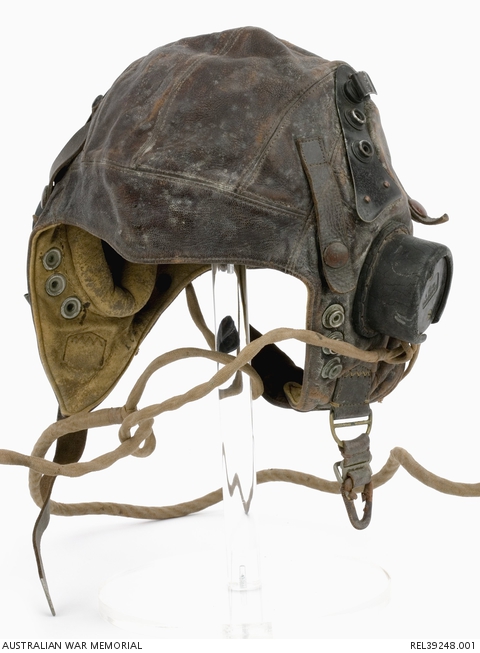| Places | |
|---|---|
| Accession Number | REL39248.001 |
| Collection type | Heraldry |
| Object type | Helmet |
| Physical description | Bakelite, Chamois, Chrome-plated metal, Leather, Plastic, Rubber, Velveteen |
| Maker |
Unknown |
| Place made | United Kingdom |
| Date made | c 1940s |
| Conflict |
Second World War, 1939-1945 |
British type C flying helmet : Flying Officer G G Richard, RAAF


British issue brown leather Type 'C' unwired flying helmet. It is complete with earphones, cord, plug and oxygen mask. The helmet has a brown leather chin strap with a 'Bennett' friction fastener, and black rubber cups protecting the external radio receivers. The left receiver is marked in raised letters 'A M' for Air Ministry with the King's crown raised in between. Beneath the letters, also raised is '10A/12443'. On the right receiver is the Air Ministry logo. Underneath this in white paint is '10A/124'. The remaining two numbers have worn away. Below the radio receivers on each side of the helmet are three chromed metal snap fasteners. On the lower two snap fasteners on the right is a flat, hooked metal receiver for the oxygen mask clasp. Attached to the lower two fasteners on the left side is a Type G oxygen mask (REL39248.002). Above each radio receiver has been riveted a metal plate with three snap fasteners attached. On the top, left hand fastener a small claw has been attached to secure a cable or strap. Either side of the metal plates has been sewn leather tabs with snap fasteners to secure flying goggle straps. At the rear of the helmet is a single buckle and leather strap also for securing the flying goggles. The insulated wiring from the radio receivers and the microphone combine under the chin of the helmet, forming a 1.8 metre cable that passes through a metal covered switch with Bakelite ends and finishes with a large bake like plug. On top of the switch is a black Bakelite volume control with a white painted arrow set into it. Stamped above this is the word 'LOW' and an arrow pointing towards it and beneath is stamped 'HIGH' with an arrow pointing towards it. Beneath this has been stamped 'A M' with the King's crown in between and '10A/13163' stamped below. Each of the markings has been painted white for ease of reading. The inside of the helmet is chamois lined, including the ear pads to reduce external noise. There is a velveteen sweat absorbing panel located at the brow of the helmet.
Associated with the service of 420490 Flying Officer George Geoffrey Richard, RAAF. Richard was born on 12 October 1921 in Burwood, NSW. After leaving school in year 9 he worked in the family business, spending two years on the factory floor and one year as a draftsman.
Richard enlisted in the RAAF on 8 November 1941, not long after his 20th Birthday. He was assigned the service number 420490 and the initial rank of aircraftman class 2. He was posted to 2 Initial Training School, Bradfield Park where he underwent basic training. He passed his course and qualified for flight training on 29 April 1942 and was promoted to leading aircraftman. Richard's next posting was to 10 Elementary Flying Training School at Temora, NSW where he learned to fly Tiger Moth aircraft.
Richard was then sent to Canada for further training. He embarked from Melbourne on 29 July, disembarking in Canada on 19 August. He was posted to 4 Service Flying Training School where he learned to fly Cessna Crane aircraft. The winter weather made flying difficult, but Richard enjoyed the challenge. He celebrated his 21st birthday during this time and celebrated with a group of fellow trainees. He completed his pilot training on 26 December and was promoted to temporary sergeant pilot on 30 December.
Richard left Canada on 25 January 1943, arriving in England on 5 February. He was posted to 15 Advanced Flying Unit flying Airspeed Oxford and Avro Anson aircraft. 21 Operational Training Unit (OTU) was his next posting, where he converted to flying Vickers Wellington III bombers. During this period, Richard was promoted to temporary flight sergeant.
He finished his conversion course and was seconded to the RAF. He was commissioned as a pilot officer and sent to 40 Squadron in April 1944. He arrived in Egypt in May and over the next four months flew 40 operations in Vickers Wellington X aircraft from bases in Egypt and Italy. On 1 September, Richard was posted to Shallufa, Egypt where he underwent a flying instructor's course. He was then posted to 77 Operational Training Unit where he instructed crews in night bombing operations.
Richard was promoted to flying officer on 16 October. He remained with 77 OTU until 20 February 1945. Operational and training flights had been wound up in the region at this time, and Richard remained in Egypt for several more months until he could obtain passage home to Australia. He returned to Australia in October and was discharged on 4 November 1945.